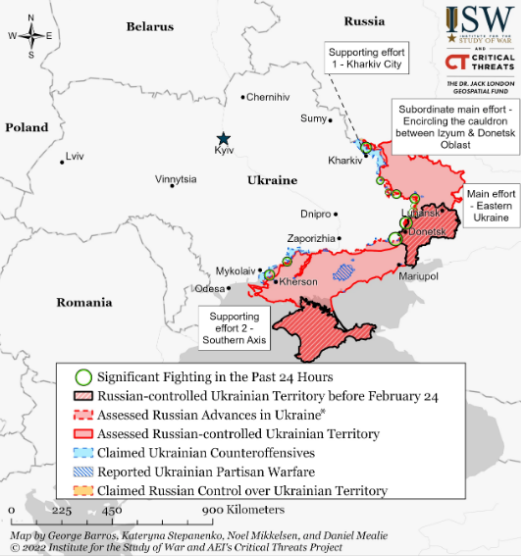Numerous courses and webinars teach entrepreneurs the finer points of starting their own business, managing a team, and attracting investment. But what do you do when your company is hit by an incoming missile or half of your employees have to go abroad?
They don’t tell you about this at the training sessions. At least not yet.
On February 24, thousands of Ukrainian companies, including our, found themselves in the new reality. What is it like to train staff to the sound of sirens, and is it worth doing at all? A large number of our clients are from Ukraine. We have been with them since the first day of the Russian invasion and have seen it happen. We tell you from real experience.
“Russian world” vs. Corporate learning
In 1996, The New York Times journalist Tom Friedman said that two countries with McDonald’s would never be at war with each other. The establishment was a kind of indicator of that level of economic development, when it is much more profitable to maintain friendly relations than to be at enmity.
But apparently this hypothesis failed.
At present, McDonald’s has temporarily suspended its work in Ukraine. As have many other companies. The reason for this was the war.
This is exactly what the map of Ukraine looks like as of this writing. One fifth of the country, 125,000 square kilometers, more than 2,500 towns and villages are under Russian occupation. That’s like two Latvias, three Switzerlands, or six Slovenias. Active fighting continues in the east and south, and the territory of Donbass is almost completely devastated.
At the beginning of 2022 there were 82 Ukrainian companies with the number of employees from 100 to 17 000 people using our development. LMS Collaborator is a functional system for staff adaptation, training and development. The majority of our team is located in Vinnytsia. It’s relatively safe here, if you can call the constant risk of a cruise missile strike and the neighborhood of Transnistria that at all. Even so, the first few months of the war were extraordinarily difficult.
Every day our managers received notifications about the temporary suspension of cooperation. After a few weeks, almost half of the clients put their work on hold. Some closed their business, others put all their efforts into saving the company and the people. Virtually everyone who could, began volunteering and helping the army. The usual mode of operation was shattered.
There is not a single company in Ukraine that has not suffered losses because of the war. And it does not matter whether it is in the east or in the west. The entertainment industry, HoReCa, and agriculture faced great difficulties.
It would seem that personnel training is the last thing that should be of concern in a situation like this. Or should it be?
Stage 1. A platform for information and psychological support
It all started with panic. No one understood what was happening and how it was going to happen, so there was no question of any kind of teaching. Companies helped their employees move to other cities or even countries. Many had to evacuate their production as well, from products to equipment.
Is it worth it to leave home? Wouldn’t it be safer to stay? There was no one to ask what to do. Everyone sought to return to something usual and familiar, to find a foothold. So, our corporate portals became a source of information and psychological support for people.
Why not messengers or social networks?
Because there is tons of information poured out on them every minute. Only company employees had access to the corporate portal. No outsiders. A modern LMS, in addition to training, has many communication functions. Here you see messages that are specific to you and your colleagues. Nothing is redundant. If there are lists of bomb shelters, not all in a row, but only those close to you.
It was the same during the pandemic. People found from their colleagues the support they so sorely lacked.
The corporate learning management systems worked as a closed information channel. Employees received accurate data on gathering places, management actions, dangers in areas of their city, communication methods organized by the company and points of help both in Ukraine and abroad, that is, all those details that should not be public.
Corporate portals have been and continue to be a source of reliable, verified information. It’s safe here.
Stage 2. The young fighter course
In March, staff information reached a new level. Checklists and methodologies were replaced by practical express courses that taught how to stop bleeding, treat burns, purify water, etc.
When cases of poisonous sprays became known, instructions on how to behave in the event of a chemical attack were added to the knowledge base. With the takeover of the Chornobyl and Zaporizhia nuclear power plants, and after threats of weapons of mass destruction, there was a demand for courses on surviving a nuclear winter.
The loss of a home, the death of relatives, and life under occupation did not go away without a trace. People were under constant tension and stress. So the number of psychological support courses increased as quickly as the number of panic attacks during the next siren.
So, after five months of war, the need to tell you how to behave in this or that situation no longer exists. Most companies have gone back to the usual training for employees. But even today, our clients continue to pay a lot of attention to chemical protection and first aid courses, because that’s the basis that everyone should know.
Stage 3. Rejection of Russian software
In the middle of April, business began to gradually come back to life and put itself together, but the entrepreneurs were well aware that it would no longer be the same. First of all it was about rejecting everything Russian. People wanted to watch, buy, and consume Ukrainian things. At this time we got a lot of requests from those who used to use Russian LMS and were looking for a replacement.
And here it is worth noting one unpleasant but important thing.
Even after 2014, Ukrainians predominantly used Russian services, especially for distant learning. Russia was the first post-Soviet country to develop such software. Their software had a huge impact on Ukrainian business.
For example, the 1C program. This is a service for financial, tax and management accounting. At the time the sanctions were introduced in 2017, the total number of users of this software in Ukraine was estimated at 350-500 thousand companies. Why is there such a large margin of error in the calculations? Because from 30% to 60% of the market were unlicensed products.
But the placement on Russian servers and sanctions did not stop anyone. What’s more! Even state companies continued to use the service. This was the case until February 24. After the full-scale invasion, clients began to abandon 1C and other programs from Russia in droves and switched to Ukrainian solutions.
Ukrainians finally saw that we have decent alternatives, which are not inferior in quality or functionality.
Importantly, the vast majority of these services are in the cloud, distributed among data centers around the world. Therefore, they have not ceased to function, unlike local architectural solutions.
We have big data centers in Dnipro and Kyiv. Therefore, when the latter suffered from attacks, it was extremely difficult for many. Due to significant power surges or destruction of power grid lines, the power was periodically cut off, access to mobile communications disappeared, and the Internet was shut down. Of course, generators were used, but they would not last longer than two days.
Cloud technology has proven to be much better than data centers. Users can access their information at any time and in any place where there is an Internet signal, and thanks to Starlink, it is now even in the epicenter of combat action.
Stage 4. Adaptation
Maslow’s pyramid is based on physiological and security needs. And for good reason! With your life under constant threat, no one mentions self-expression, creativity, or recognition. After moving their families out to safe cities, people, first of all, began to think about how to live their lives and what to buy their groceries with. They had to get back to work.
The LMS Collaborator is a cloud-based service and can be accessed from any device as long as there is internet. Our team did not stop monitoring the platform even when each of us was rescuing our families and volunteering. All services worked continuously from the first day of the invasion. We were always in touch, both with each other and with customers.
As soon as things were more or less stabilized, we were able to systematize our work remotely, because we were in different cities and even countries. We had to learn how to work under air-raid alarms. When the siren sounds, we interrupt meetings, webinars, and briefings and move to a shelter. But the benefits of eLearning are that the laptops come with us.
More than half of our clients have continued staff learning. To date, we have managed to reach a preliminary level of income, because the vast majority of companies that paused are gradually returning to cooperation. It is true that the vector of corporate online training has undergone significant changes.
According to the UN, more than two and a half million citizens left Ukraine in the first two weeks of the war. Now the figure is about five million. 96 percent of companies have workers who are abroad. Another ten million have left their jobs and moved within the country as internally displaced. That’s why companies must now close the problem of staff shortages and train new employees. Adaptation courses in sales, consulting, and tech support are most popular.
In this sense, the experience of COVID-19 was very useful.
During the pandemic, we asked all workers to stay home for their safety. But as soon as the opportunity arose, many returned to the office because working remotely was sometimes extremely difficult. Eventually a hybrid format became common, where on certain days you can come to the office and on other days you can work from home.
The first months of the war were like March and April 2020. We all worked from home, and our office became a place to sleep for our friends who had evacuated their families from the shelling. Now we’re back to a hybrid model. Some people work remotely because they have no one to leave their children with because schools and kindergartens are closed. Some, on the other hand, have a lot of people per square meter, so they prefer office work.
Everything is constantly changing. Companies have to adapt to external challenges. There are no clear long-term plans. All decisions are made very soon, and the old strategies for personnel development are in the past. But whatever the case, one thing I know for sure – without the experience of quarantine life that we all gained through COVID-19, it would be much more difficult for companies to set up work processes under wartime conditions.
Conclusion
A platform for distributing reliable information or a portal for talent development. Adaptation of new employees or formation of a talent pool. Hard skills courses or psychological support programs. This is what companies in Ukraine are paying maximum attention to now during the war. Each of them chooses what and how to train their staff, but it is definitely worth doing, because now more than ever, everyone understands that people are the most important resource.






Leave A Comment